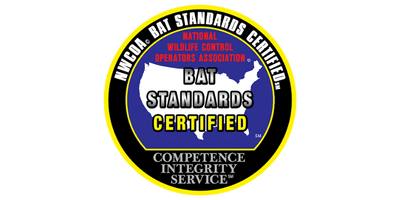Frequently Asked Questions
Are bats a protected species?
Advanced Wildlife and Pest Control follows all local, state, and federal regulations to ensure bats are protected throughout the removal process. All exclusion techniques cause no physical harm.
What are signs of a bat in my house?
I have bats living in my attic/home; "What Do I Do?"
Advanced Wildlife & Pest Control performs more bat exclusions than any other wildlife and pest control company in Wisconsin. We are also the largest animal removal and pest control company in Wisconsin. We stand by all the work we perform and provide a 2-year guarantee for all our bat exclusions.
I have a bat flying around my house; "What Do I Do?"
What should I do about a possible rabies exposure?
What if you are not sure?
If you wake up and find a bat in your room, the bat should be safely captured and tested. We would also strongly recommend getting the rabies vaccination just for precaution. The same precautions should be used if you find a bat in a room with an unattended child or disabled individual that can not properly communicate an interaction with a bat.
Over 30 years, we have captured approximately ten bats that turned out positive for rabies. Under no circumstance should you release a bat that has bitten or scratched you.
Will bats go away on their own?
What are the health risks of having a bat colony in my house?
Bats in your house will also produce piles of bat droppings in the spaces they inhabit. Bat guano is particularly hazardous due to the Histoplasma fungus found in them. Histoplasmosis is a disease that attacks the respiratory system when someone breaths in the fungus particles.
Why do I need professional bat removal?
Advanced Wildlife & Pest Control performs more bat exclusions than any other wildlife and pest control company in Wisconsin. We are also the largest animal removal and pest control company in the state. We stand by all the work we perform and provide a 2-year guarantee for all our bat exclusions.
Is the bat removal process safe?
How long does a bat exclusion take?
Why should we protect bats?
What is Wisconsin doing about white-nose syndrome?
Get in Touch!
Email: info@advancedwildlifecontrolllc.com
Address: 850 Enterprise Drive, Slinger, WI 53086
Hours:
Mon. – Fri. ………. 7 am – 7 pm
Sat. – Sun. ………. 8 am – 3 pm
24/7 Emergency Services Available







